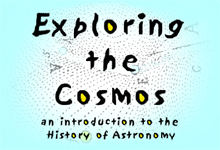

Department of History
University of California, Irvine
Instructor: Dr. Barbara J. Becker
![]()
Lecture 20. The Redshift Controversy.
![]()
Quasars have been the subject of controversy since their discovery in 1963 by Maarten Schmidt (1929- ) and Jesse Greenstein (1909-2002). Are quasars located at cosmological distances, as Hubble's redshift/distance relationship assumes? Or, are they evidence of a serious flaw in our understanding of the natural laws that govern the behavior of large-scale phenomena? How does the scientific community respond to individuals who develop and promote views that question mainstream ideas about how the world works? |
During the 1950s, radio and optical astronomers worked together to match individual sources of radio emission with their optical counterparts on the sky. By 1960, this effort had achieved some success: astronomers had identified quite a few radio sources as coincident with objects that appear on the visible sky -- all of these objects appeared to be galaxies.
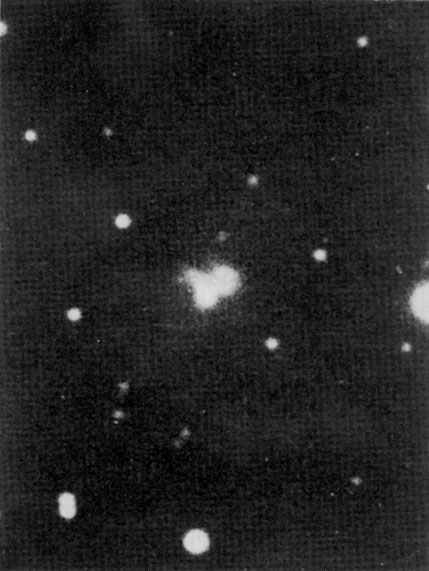
The unusual galaxy, Cygnus A, seen in optical wavelengths.
When astronomers analyzed the spectra of the visible light from some of these radio galaxies, like Cygnus A, they found a direct correspondence between their apparent brightness and their measured redshifts. This finding enhanced astronomers' confidence in utilizing Hubble's redshift/distance relationship for determining the distances to these objects. Applying it to Cygnus A placed this object at a distance of around 1 billion light-years.

A visual representation of Cygnus A in radio wavelengths.
In 1960, there were still a number of reasonably strong radio sources with no obvious optical counterpart. One such radio source, 3C 48, occupied a relatively uncluttered region on the sky. When Allan Sandage (1926-2010) photographed this area using Palomar's 200-inch telescope, he found a faint, blue star-like object in place of the expected galaxy. The object possessed some unusual characteristics that made it difficult to classify. Its broad-emission spectral lines were particularly puzzling in that they did not seem to match anything that was then known to exist.
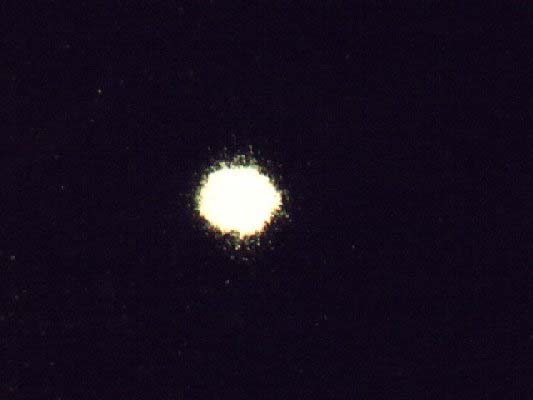
"Stellar" radio source, 3C 48
Meanwhile, the search continued for other visible sources of radio emission using lunar occultation techniques. Martin Schmidt found a faint, slightly fuzzy, blue star-like object at the site of 3C 273, a radio source that shared many of the unusual spectral characteristics noted in 3C 48. Because of their star-like appearances, these powerful radio sources came to be called, for lack of a better term, quasi-stellar radio objects. This was soon shortened to "quasar."
Spectrographic analysis of the light from a celestial body is one method astronomers use to ascertain its chemical composition and to infer other physical characteristics such as its temperature, density, and magnetic field strength. It is not always easy, or even possible, to interpret a spectrograph unambiguously, especially if there is nothing remotely similar to it with which to compare.
Jesse Greenstein struggled with the 3C 48 spectral puzzle. Its exotic properties seemed to require exotic mechanisms. He suggested it was a star of unusual density powered by the radioactive decay of such heavy metals as curium, neptunium, and plutonium. At roughly the same time, Schmidt was toying with the periodic spacing in the unusual spectrum of 3C 273 and comparing it with the known periodicities of hydrogen's Balmer series. In doing this, Schmidt recognized that the mysterious spectral lines in 3C 273 were identical to those produced by hydrogen gas, but shifted by 16% toward the red. Because of this dramatic shift, no one had suspected the association.
Schmidt conferred with Greenstein. Analysis of 3C 48's spectral signature indicated a 37% shift! If Hubble's galactic redshift/distance relationship were applied to these objects, 3C 273 would be located about 3 billion light-years from us, while 3C 48 would be at the incredible distance of over 5 billion light-years!

Schmidt's proposed solution to the quasars' spectral problem required no exotic mechanisms to explain the observed spectral lines, but it raised new and more challenging puzzles about the physical nature and structure of these two unusual bodies.
The sense of puzzlement increased when, within a short period of time, more objects with the same spectral characteristics were discovered with redshifts that suggested they were located at even greater distances. Astronomers were amazed that anything located much farther than 5 billion light-years away could be seen. Even galaxies -- the largest and most luminous known sources of light in the sky -- would be scarcely visible at such distances. How can quasars appear as bright as they do? If they are really as far away as the shifts in their spectra suggest, they must be a thousand times more luminous than galaxies like the Milky Way. What kind of energy source could power such an object for any length of time?
Because luminosity is a function of surface area as well as intrinsic energy, it was entirely possible that quasars are simply enormous bodies compared to normal galaxies despite the fact that photographs showed them to be star-like points instead of extended objects. To check this out, attempts were made to estimate the size of quasars. Surveys of old photographic plates on which the handful of known quasars had been unwittingly recorded revealed that their light output varied periodically over relatively short periods of time. This put a natural cap on quasars' size range from a light-day to perhaps a few light-years in diameter. By comparison, our Milky Way galaxy is estimated to be approximately 100,000 light-years across.
The limit on quasar size was key to the eventual development of the quasar controversy. When quasars were first identified and their redshifts measured, it seemed reasonable that the redshift/distance relationship should apply to this new class of objects just as it had to the recently discovered radio galaxies. Quasars would have added coherence to the conventional, expanding universe interpretation of galactic redshifts if only they had turned out to be distant versions of nearby galaxies. But, given their short-term variability and high apparent luminosity, quasars could not easily be fit into any existing theoretical framework.
As early as 1964, some astronomers began to question the applicability of the Hubble redshift interpretation to the case of quasars. New York Times science writer, Walter Sullivan described the state of theoretical flux in the community of astronomers at the close of the second conference on the nature of quasars held in Austin, Texas that year:
The conference ended in an atmosphere of uncertainty and excitement: uncertainty because interpretation of the data leads to conclusions that are hard to believe: excitement at the possibility that a rare event in science may be at hand -- the discovery, in an utterly new kind of phenomenon, that supposedly immutable laws are invalid.
Could it be that quasars are actually nearby and that their redshifts are produced by something other than universal expansion?
The power of the past success of the cosmological interpretation of galactic redshifts coupled with the hope that quasars might serve as "probes" of the structure and character of the early universe led most astronomers to accept the validity of the Hubble relation and to consider the obvious physical peculiarities of the quasars as part of the challenge of an exciting research problem.
For other astronomers, however, the physical problem of explaining the energy output of quasars at cosmological distances far outweighed the difficulty of explaining their redshifts in ways that would permit them to be considered local objects. These individuals viewed quasars' anomalous redshifts as the research problem most likely to reveal something fundamental about the physical processes that govern the production and behavior of matter and energy in galaxies.
This resembles what Thomas Kuhn has called, in his classic Structure of Scientific Revolutions, the "crisis" phase of a scientific revolution. Astronomers, regardless of their interpretation of quasar redshifts, had reached the point where they could no longer ignore the quasar energy-source/size paradox. But, while Kuhn moves the crisis-bound scientific community on to the development of competing paradigmatic alternatives, he offers no suggestions as to how this can happen. He says, "Crisis loosens the rules of normal puzzle-solving," and competing alternatives just appear in the midst of the crisis.
I would argue that no loosening of the rules is required to generate alternative views in a scientific community. The diversity which makes this sort of creativity possible is always actively present within the community.
Scientific communities are comprised of individuals who agree, in general, on many things: who may become a member of the group, what questions may be asked, and how those questions may be investigated. From an outsider's perspective, it can appear that all members of the group talk, think and act very much alike. |
 |
Insiders mask the dynamic diversity within their community through their use of jargon and group-specific symbols in public accounts of their work. |
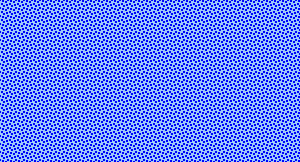 |
A quick check of a few issues of professional journals reveals something of the background noise in the community's ideas, explanations, questions and suggestions.
|
 |
| Moving in closer or talking to a few individuals reveals this diversity even more clearly. | 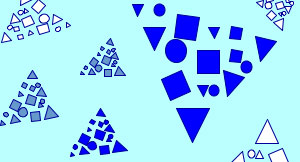 |
So long as the range of differing views remains small, the diversity within a scientific community enriches its already fertile work environment. Diversity inspires and guides individuals' everyday investigative efforts. It insures the community's resilience in the face of distracting and potentially disruptive anomalous discoveries.
When disagreements give rise to controversy, however, the diversity within a scientific community becomes visible -- or at least more clearly recognizable -- to outsiders, giving the impression it has "suddenly" appeared.
When controversy arises in a scientific community, like-minded individuals (symbolized here by the dark blue circles) separate from the larger community by choice and/or coercion. The community's old dynamic equilibrium is temporarily disrupted. |
 |
| The form and extent of the community's once-hidden diversity becomes visible to outsiders as individuals position themselves along the axis (or axes) of the disagreement. | 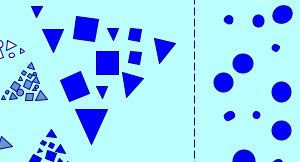 |
| To resolve the controversy and restore the community's dynamic equilibrium, individuals re-examine and clarify the theoretical and methodological underpinnings of the paradigm that guides their work. | |
| In time, the differences either become more clearly established... | ...or become absorbed in a new paradigm. |
 |
 |
| Either way the controversy is resolved, the group(s) will work toward restoring a uniform public face. | |
 |
 |
The basic elements of the controversy surrounding the interpretation of quasar redshifts were on the table within a year following the discovery of quasars. Creative speculation exposed the diversity underlying the superficial unanimity of the astronomical community. The difficult process of developing plausible alternatives to the conventional cosmological view began in earnest.
During the period which followed, roughly 1964-67, many theories about the nature of quasars were suggested by a wide segment of the astronomical and physics community. These theories helped shape the direction of the redshift controversy and the form of the two principal rival theories that emerged.
Articles in the popular press emphasized the mysterious nature of quasars and listed numerous speculations presented by scientists at the many conferences which were held to discuss them. In 1967, Jesse Greenstein was moved to write the following lament:
Horrid quasar
Near or far,
This truth to you I must confess:
My heart for you is full of hate
O super star,
Imploded gas,
Exploded trash,
You glowing speck upon a plate,
Of Einstein's world you've made a mess!
Textbooks introduced the quasars as examples of interesting puzzles in modern astronomical research.
Professional astronomers who believed that quasars might be easier to understand if they were considered to be local rather than cosmologically distant objects began to discuss alternative explanations for observed redshifts. James Terrell, for example, suggested that quasars might actually be physically moving away from us at relativistic speeds after being ejected from the center of the Milky Way about 5 million years ago. Fred Hoyle (1915-2001) and Geoffrey Burbidge (1925-2010) proposed that they might have been thrown from a nearby galaxy (Centaurus A) in a cataclysmic explosion.
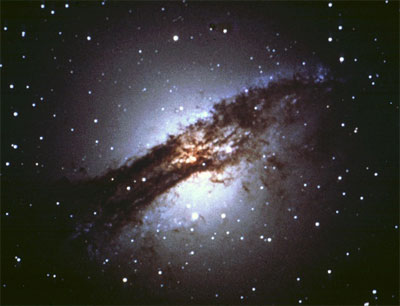
Peculiar galaxy, Centaurus A, photographed in visible wavelengths
Questions about the conventional Hubble interpretation of galactic redshifts had come up even before quasars were discovered. Astronomers had measured discordant redshifts among members of small galactic groups which appear to be physically associated, like Stefan's Quintet.
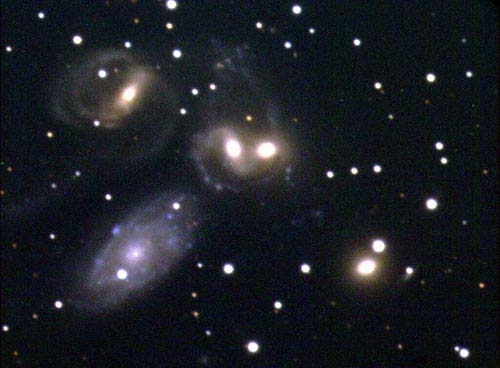
Stefan's Quintet
In addition, some galaxies, like M87, possessed extended active jets that spewed clumps of material into space from their centers. Other galaxies appeared to be exploding.
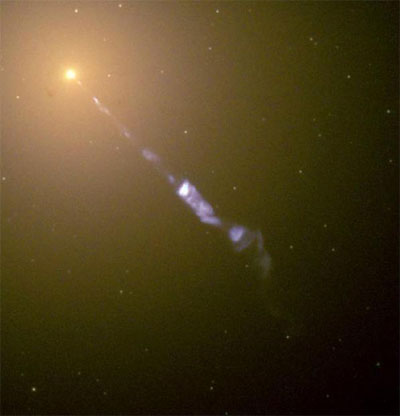
M87 and its jet
Astronomers looking for a covering theory for these observational problems saw ejection theories as inviting possibilities. Viktor Ambartsumian (1908-1996) suggested that galaxies eject luminous material which then forms the seeds for new galaxies. In 1961, at a conference on instabilities observed in galaxies, the possibility was raised that galaxies might be capable of ejecting galaxy-sized material in order to explain discordant redshifts among members of Stephan's Quintet, Seyfert's Sextet and the chain of galaxies known as VV 172. These ejection theories influenced the development of the local interpretation of quasars.
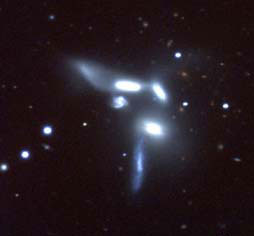 |
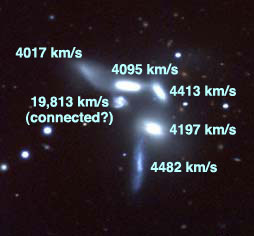 |
Seyfert's Sextet |
|
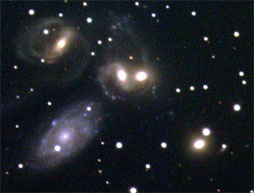 |
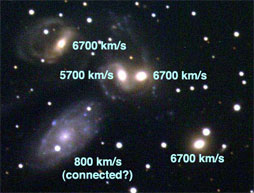 |
Stephan's Quintet |
|
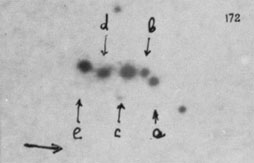 |
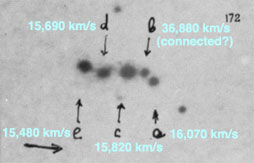 |
VV 172 |
|
Astronomers who supported the cosmological interpretation of the quasar redshifts needed to account for the tremendous energy required to power the luminous quasars. The theories they developed grew out of speculations aimed at solving observational problems in related objects. They turned to mechanisms such as chain reaction supernovae, violent stellar collisions, cataclysmic galactic explosions and gravitational collapse -- mechanisms that had been discussed as possible sources of intense radio emission in some galaxies.
![]()
Some may view the theories generated during this period as non-scientific. Certainly, none of them could be tested directly. There were insufficient numbers of quasars known to make their observed characteristics statistically analyzable. Available photographic information was inadequate to reveal much in terms of the physical structure of quasars.

Halton Arp (1924-2013)
This changed in 1966, when astronomer Halton Arp finished compiling the Atlas of Peculiar Galaxies, a catalogue of objects like spiral galaxies associated with various types of companions, spirals with disturbances in their spiral arms, galaxies with filaments that connect them to other nearby galaxies, groups, chains and clusters of galaxies. Arp arranged these objects morphologically in order to facilitate the comparative study of physical characteristics in similar objects.
Arp searched the Atlas for possible relationships between peculiar galaxies and known radio sources. He found that for one type of peculiar galaxy (ellipticals with either disturbed spiral galaxies nearby or disturbed material that appears to be ejected from these ellipticals), 36% were located almost exactly midway between, and thus formed a line with, two nearby radio sources. Of these radio sources, five turned out to be known quasars. Arp calculated that there was only a 1:1500 probability that such an alignment could occur by accident. He concluded that the objects were physically associated with one another in some way, even though the redshifts of the quasars were considerably higher than the redshifts of the galaxies. A conventional interpretation of the data would suggest they were simply at different distances along the line of sight.
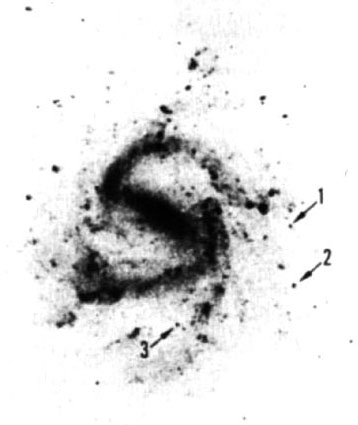
NGC 1073 and quasars
In 1966, an article by Arp appeared in Science describing associations between quasars and peculiar galaxies. In it, he mentioned ejection as a possible cause for the disparity in redshifts and urged caution in applying the redshift/distance relationship to all other galaxies as well. Soon, his claim that quasars and peculiar galaxies were associated with one another was tested by others. Their results neither confirmed nor refuted Arp's interpretation, but they did raise questions about his statistical methods.
One year later, in the first account of his interpretation to appear in an astronomical journal, Arp stated, "It is with reluctance that I come to the conclusion that the redshifts of some extragalactic objects are not due entirely to velocity causes...".
No one questioned that the peculiar galaxies Arp had studied were located at their redshift-determined distances, nor did they doubt that some quasars appeared to be near these galaxies. But it was not so clear that these objects were, in fact, physically connected to one another rather than just an illusory alignment on the sky.
Arp suggested a new way of looking at the quasar problem and testing the competing redshift interpretations. In this way, he attempted to set the terms of the first round of the redshift controversy.
The expeditious establishment of mutually agreed upon terms of debate influences the length of time a controversy can continue. The dispute over the reported discovery of the magnetic monopole, for example, was relatively short because there were no disagreements on the terms of the debate or the standards of evaluating success vs. failure in attempts at experimental verification.
By contrast, it took twenty years to end disagreement over claims for learning in planarian worms because the terms that would have permitted agreeable resolution of the controversy continued to evolve rather than resolve. Similar shifts have extended the long-lived asteroid impact/dinosaur extinction controversy and are doing the same for the current debate over climate change.
This may help explain the longevity of the redshift controversy. After Arp attempted to establish the terms of debate in his original articles, cosmological theorists countered with their own criteria. An article critical of Arp's statistical methods by Harry van der Laan and Frank N. Bash appeared in the Astrophysical Journal a year after Arp's. The authors argued that Arp relied on faulty method and reasoning in his use of statistical evidence to support his claim of peculiar galaxy/quasar association. It is risky, indeed, poor form, they claim, to identify objects that happen to appear close to one another on the sky as physically connected to one another rather than as an illusory association, especially if one is unsure about the reliability of the method used to determine the distance to each of the objects.
In addition to claiming that Arp unjustifiably identified his associations purely on the basis of apparent proximity on the sky, van der Laan and Bash accused Arp of confining his treatment to examples that served to "strengthen the case already made." They presented what they believed to be a more objective treatment of a data set similar to Arp's -- namely, a search for aligned quasar pairs against a set of arbitrarily positioned control catalogue points -- in order to show that even when dealing with such a speculative problem as this, one can employ test measures which do not involve the use of a posteriori statistical analysis. The argument against Arp's a posteriori statistical methods is still raised whenever his work is discussed by cosmological theorists. Some express puzzlement over Arp's apparent inability to grasp the problem he has with his statistics.
| Imagine a survey of houses in a town has found a number with chimneys on which storks have built a nest. Among those houses, are several occupied by families with newborn infants. Is it reasonable to conclude that the two observations are causally related? How might such a conclusion be tested? |
Arp defended his analytical approach by pointing out that it made no sense to include in his survey types of galaxies that had no possibility of being associated with quasars. Thus, rather than working towards an agreement on the original premise of the controversy, Arp maintained the legitimacy of his methodology and, latching on to observations made by Burbidge, et al., he shifted the focus of the debate to tests of associations between bright galaxies and quasars. As the controversy developed, Arp's focus shifted again and again -- first to tests of physical associations of chains of galaxies with discordant redshifts, later to studies of associations between low-redshift bright galaxies with high-redshift companion galaxies and quasars. Meanwhile, the cosmological theorists sought new ways of demonstrating that Arp's statistical methods were unacceptable regardless of the type of association he was examining.
Astronomer Daniel Weedman has described this back-and-forth process:
The sequence of events has been something like this: a curious fact is discovered within a given quasar sample; perhaps that quasars in a given magnitude range lie closer than expected to peculiar galaxies. That observation cannot produce a meaningful hypothesis unless it can predict a result that will be found using a new, independent sample of quasars. Producing such a sample is tedious and involves a lot of work at the telescope, but somebody eventually does it. Upon reanalysis, the initial curious fact is not confirmed. 'That's unfortunate,' comes the response, 'but notice there is a different curious fact in this new sample....'. So a new curiosity has to be tested, requiring yet another new sample. It can be readily appreciated why this becomes a frustrating game.Weedman's expression of frustration in this passage gives voice to a widely held concern in the astronomical community over what it sees as the ad hoc nature of Arp's views. It is difficult for those who support the cosmological interpretation of quasar redshifts to see that Arp's ideas hang together in any coherent way. There is no over-arching theory holding all the problem-specific explanations together.
In response to these charges, Arp argued that it is not the role of the research scientist to confine the interpretation of what is observed within the limits of preconceived expectations. He chastised those who:
start with a theory which they feel must be true, then look for observations that can be explained by their theory, and finally declare that their theory 'explains everything.' ... It is clear that I espouse here the Baconian principle of induction of general laws, from a body of observed facts. It would seem obvious that if a scientist only reasons deductively from known laws then he or she can never do more than recover those laws, and will never discover anything fundamentally new.In Arp's view, his ability to find similar, albeit anomalous, behavior in such a wide variety of circumstances generalized rather than trivialized the fact that the conventional interpretation of galactic redshifts must be examined in a new way, perhaps under the theoretical umbrella of a provocative theory like that proposed by Fred Hoyle and Jayant Narlikar, namely that electron mass is not a constant, but rather increases over time.
Weedman's statement underscored his own conviction that the cosmological interpretation is the right one and that, sooner or later, local theorists would have to admit defeat -- in fact, the sooner, the better.
Meanwhile, Arp's advocates voiced concern over the popularity of Weedman's attitude and its implications for continued objective observational research.
The disagreement between the two sides shows the community as a whole working to clarify and give explicit expression to what formerly had been tacit, or perhaps ill-defined, and/or poorly understood standards of proper methods for data collection and interpretation. The goal of the minority is to have a fair hearing of its views, while the goal of the majority is closure so the diversity within the community can return once again to its relative invisibility, so the normal lines of authority can be reinstituted, and so the unanimity in the public face of science can be once again restored.
![]()
Throughout the 1970s, work done by astronomers on both sides of the controversy led each group to feel it was making headway in resolving the redshift question. Continuing disagreement over methods of statistical analysis resulted in a growing belief that the issue would have to be settled observationally. Thus, the photographic search for luminous filaments connecting galaxies and quasars, or high-redshift galaxies with low-redshift galaxies of any kind, suggested by Arp in 1968, became a focal point of discussion.
This phase of the controversy was accompanied by some of the same back-and-forth activity to which Weedman had referred in connection with the arguments over statistical methods.
While Arp claimed to have photographed a number of objects with discordant redshifts that are clearly connected to one another, I will focus on one particular case, which Weedman has referred to as "the notorious pair NGC 4319-Markarian 205 ... considered by some to be the fulcrum of the entire redshift controversy."

NGC 4319 and Markarian 205
NGC 4319 is a spiral galaxy which is relatively near the Milky Way (110 million light-years away). It has a low redshift (z = 0.006). Mrk 205 is a very compact object which appears to lie within the spiral arms of NGC 4319, but it has a much higher redshift (z = 0.07) and has been identified as a low-redshift quasar. If its redshift were interpreted conventionally, Mrk 205 would be located about 1.2 billion light-years, or 10 times farther, away.
Arp photographed these objects using the 200-inch telescope at Palomar to see, as he stated, "whether any effects were visible in the two objects which might give direct evidence that they were close to each other in space." He was "surprised and excited to find a luminous connection between the quasar and the galaxy." After convincing himself that it was not an artifact, he published the photograph seen above in Astrophysical Letters in 1971.
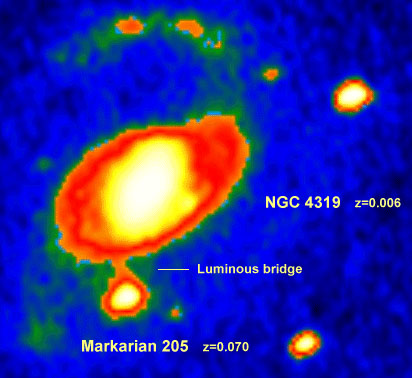
This false color photograph taken in 1998 by amateur astronomer David Strange, highlights the luminous bridge Arp claims connects NGC4319 and Mrk 205
Shortly after the photograph appeared in print, other observers photographed the pair to verify Arp's claim. Lynds and Millikan claimed to have found a luminous bridge, but felt that it more likely resulted from "the overlap of the brightness distributions of the two objects," or perhaps the presence of a faint background galaxy in that location. Neither Ford and Epps, nor Adams and Weymann were able to find evidence for a connection on the photographs they took of the pair.
On 30 December 1972, Arp was able to confront a proponent of the cosmological interpretation, John N. Bahcall, in a debate on quasar redshifts sponsored by the American Association for the Advancement of Science. For a number of astronomers, this debate is viewed as the culminating event of the controversy. Arp used his photographic evidence for the bridge between NGC 4319 and Mrk 205 as one of his principal examples of objects with discordant redshifts that appear to be connected by luminous filaments. Bahcall responded by citing the above-mentioned failed attempts to verify Arp's claim and warned:
The moral of the story of the apparent connection between NGC 4319 and Mrk 205 is clear: Seek and ye shall find, but beware of what you find if you have to work very hard to see something you wanted to find.This might be described as the second commandment of observational astronomy, after "Beware of cosmologies that give Earth a unique view of the universe."
In August 1973, Arp presented the case of NGC 4319 and Mrk 205 as the focus of a talk at the International Astronoical Union's symposium on galactic dynamics in Canberra, Australia. In addition to his original discovery plate, Arp exhibited isophotal images of the objects observed with the new isodensity tracer at the Jet Propulsion Laboratory in Pasadena, California. Using these images, Arp was able to show inner distortions within the nucleus of NGC 4319 that were not visible on ordinary photographic plates. In Arp's interpretation, these distortions seem to align with Mrk 205 and a new radio source located directly opposite Mrk 205 on the other side of NGC 4319.
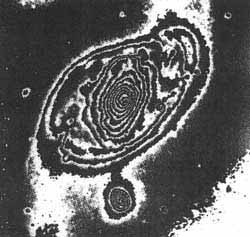
Isophotal image of NGC4319 and Mrk 205
Arp gave a very similar presentation one month later at an IAU symposium on cosmological theories held in Cracow, Poland. In this talk, he emphasized what he believed to be the conclusive nature of his observations:
I would like to point out that ... as is true of the earlier examples discussed in this paper, we need only one established case of a discordant redshift to force a crucial confrontation between observation and the current physics on which cosmology is based.Articles on this pair of objects published by other astronomers in the years that followed continued to present the luminous bridge between them as an artifact in Arp's photographs. The issue had reached an impasse when, in 1976, Arp teamed up with Jean Lorre, an image specialist at the Jet Propulsion Laboratory's image processing laboratory. Together, Arp and Lorre worked on enhancing the contrast and clarity of nebulous features in existing photographic plates of objects whose structure had not yet been resolved, objects like Stephan's Quintet, Seyfert's Sextet, and M87.
A short time later, Jack Sulentic, then a post-doctoral fellow, began working with Lorre. Six years later, this collaboration culminated in an article by Sulentic in which he claimed positively to confirm the connection between NGC 4319 and Mrk 205. Not only are these objects connected, Sulentic claimed, but the luminous filament bridging them leads directly back into the nucleus of NGC 4319.
Alan Stockton, who had previously described the luminous bridge between these two objects as a photographic artifact, admitted, on the basis of the good quality of Sulentic's latest images, that there is, after all, a luminous filament present. However, Stockton remained skeptical on how to interpret this luminous filament. In his view, it did not imply that the pair are connected. Rather, he claimed it showed an interaction between Mrk 205 and another object near it with the same redshift.
In August 1987, a pair of articles by Arp and Sulentic appeared in the Astrophysical Journal in which they elaborated further on the results of their image processing work with NGC 4319 and Mrk 205. These image enhancements showed a continuous luminous connection extending from Mrk 205 back into the nucleus of the spiral, thus confirming the work done earlier by Sulentic. They also revealed a narrow spine-like feature stretching outward in either direction from the nucleus. On the end of this spine, a bright, compact ultraviolet object was found. Arp claimed this to be confirming evidence of explosive nuclear activity.
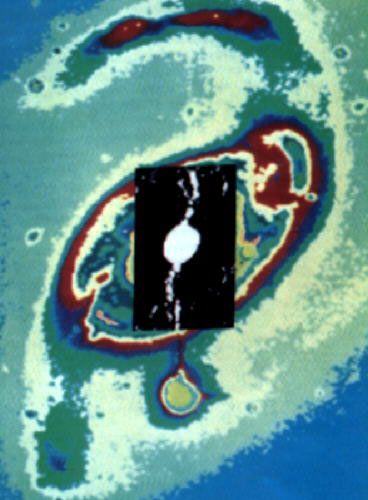
Visual proof, or illusion?
![]()
There is a functional limit to the amount of diversity a group can tolerate and still maintain its structural integrity. Failure of some members to conform can lead the majority to take a variety of actions against the maverick minority.
If the majority includes the powerful elite of the community -- those who hold the pursestrings or control the utilization of costly research equipment -- the minority may have its entire scientific effort cut off at its source. Even if the majority does not possess that much power, it can control communication and social networks on both the formal and informal levels effectively enough to make professional life and advancement difficult for dissenters. Most importantly, the majority can endure a war of attrition more easily than the minority.
It is not easy to observe disciplinary action within the scientific community from afar. Most formally published scientific accounts do not reveal much about the mechanisms of control to outsiders. Professional journals and conferences do not publicize lists of papers they have rejected (along with reasons). Unless transcripts are published of discussions generated by the delivery of a paper, it is difficult to know how it was received at the time. Even when discussion notes are kept, there is no record of who had coffee with whom between sessions, what was said in the groups in the halls outside the conference rooms, or who was talked "about" rather than "with". This kind of information must be gathered more indirectly.
Still, the published record does provide some insight into certain aspects of disciplinary action, particularly those that involve the wielding of power by the elite within the majority. In Halton Arp's case, there have been instances when members of the astrophysical community, who adhere to more conventional views concerning the interpretation of galactic redshifts, have attempted, in both formal and informal ways, to exert their influence in order to restrict Arp's professional activities or prevent him from successfully speaking out on his views.
In the course of the AAAS debate in December, 1972, for example, John Bahcall (1934-2005) related a story (which he emphasized was "not intended to be realistic") of a fictional report by an imaginary Dr. X whose poor methodology and reasoning skills led him to conclude that stars in the Milky Way had actually been ejected from explosions in spiral galaxies. Bahcall described the data collected and interpreted by Dr. X in precisely the way Arp had argued for quasar ejection from active galaxies. In fact, the emphasis on the fictitious nature of this example only amplified the ridicule aimed at Arp.
Daniel Weedman has described Arp's Atlas of Peculiar Galaxies as the "Atlas of Funny Things." Also, Weedman's glib caricature of local theorists' attempts to find and present evidence supportive of their ever-changing claims was written in a book intended for use as a text for advanced students of astronomy potentially shaping the attitudes of developing astronomers towards this dissident view.
Drastic forms of discipline can be wielded by individuals who, in spite of their claimed interest in encouraging exploration of new and innovative avenues of research, have come to believe that the work being done by a dissident member of the community is of insufficient quality or value that it must not be permitted to continue because it consumes limited resources needed for the work of the group as a whole. Such serious disciplinary action was taken against Arp in 1983 when his request for telescope viewing time at Palomar was denied.
In November, 1981, Arp received a stern warning from Palomar's Time Allocation Committee (TAC) threatening him with loss of the use of the telescope if he did not significantly alter the thrust of his research programme. This move to terminate an individual's long-running investigation on the grounds of doubt as to its usefulness was viewed by many at the time as unprecedented. George Alexander, science writer for the Los Angeles Times, likened Arp's loss of telescope time to the loss of hospital privileges for a physician, or disbarment for a lawyer. In Alexander's view:
The Arp case provides a rare view of how science copes with dissent. Some might conclude that the dispute is a classic example of a dissident voice being stifled by a powerful majority. There is something of that, but there are other important aspects as well: How far from the mainstream of a given field can a scientist wander before he has effectively cut himself off from his colleagues?According to Alexander, the Time Allocation Committee advised Arp that it regarded his research "as lacking focus and specific goals." The director of the Hale Observatory, George Preston, was quoted as saying, "[Arp has] been advised [that his work has become repetitive] not only by this committee, but also at other times by individual friends, privately." The Times reported that in spite of these warnings, Arp was planning to "continue to look for anomalous quasar-galaxy associations" -- behavior which would was sure to "rankle his colleagues."
The Time Allocation Committee consists of six members, three from Caltech and three from the Carnegie Institute. Every year, it meets in November to consider the numerous applications for telescope time that it receives, and tries to fit them into the 365 available nights. The description which the Committee provides for public consumption concerning its decision-making process emphasizes the objectivity and high standards the Committee employs in considering each individual's request for time in order to assure that those research projects concerned with the most pressing astronomical issues get priority. But, Arp denied that this is always the case. With his experience as a past Committee member tempered by his new status as a rejected applicant, Arp claimed that in spite of their public image of objectivity:
somehow or other the first prize [best viewing nights, most time] was regularly won by the committee members' own programs ... those observers awarded the most time would be perceived to be the most important and influential.The following November, in spite of the Committee's threats, Arp was given time to observe at Palomar, although he was allocated considerably less time than he had requested. One committee member, S. Eric Persson, a Carnegie staff member, told the LA Times that the Time Allocation Committee had had difficulty determining whether Arp had really made the requested changes in his research objectives.
While some astronomers expressed regret that Arp's observing time had been reduced, one astronomer I spoke with stated that many astronomers he knew were surprised that the Committee gave Arp as much time on the big telescopes as they did for as long as they did, since the direction of Arp's research was not the only issue -- there were real questions concerning the quality of his work as well. He believed Arp received a fair hearing from the Committee. In his view, researchers have an obligation to present their ideas in a convincing way. As he put it, "It is possible to be completely right about something, but that can become trivial if no one else is able to be convinced."
In November, 1983, the TAC cut Arp's access to Palomar completely, and in 1984, he was denied viewing privileges at Las Campanas as well. He has since joined the staff of the Max-Planck-Institute for Physics and Astrophysics in Munich.
![]()
In 1987, Arp published a book, Quasars, Redshifts and Controversies, to bring to light the facts of the redshift controversy as he viewed them. In the preface, he stated that he has taken this step because it "offers the only possibility of discussing this subject in a meaningful way at this time...."
He further claimed that he tried "to write in a way that is comprehensible to nontechnical readers," thus moving the debate into the public arena. The wisdom of such a move is debatable. Problems arise when a scientific controversy is removed from the confines of the community's jurisdiction. Scientists dislike this tactic because it introduces alien standards into the process of resolving what the community sees as a professional controversy. Often, involving the public only serves to prolong the dispute. The positive sense that the flexibility of informal discussion of scientific information promises often must be weighed against the negative effects of its capriciousness.
When does it become worth the risk to make a move like this? Does it ever pay to work at promoting controversial views from outside the boundaries of normal scientific debate if the majority view has declared victory by fiat? What if there appears to be no hope of recourse within the system as normally structured? Will the truth eventually come out anyway, perhaps through some serendipitous discovery in another line of research? When do appeals to outsiders for help in making a case become symptomatic of what Irving Langmuir once called "pathological science," that is, scientific investigation in which one finds the following characteristics:
That the larger astronomical community came to view the controversy as closed can be seen in the work of the Astronomy Survey Committee. In 1983, this committee was charged by the National Research Council with the task of "assessing the opportunities for progress across the entire range of astronomical research and with making recommendations concerning the programs and facilities needed to meet those opportunities."
The report of the working group on quasars states:
the long-standing controversy over the nature of red shifts came close to resolution [over the past ten years].... It seems likely that quasars as a class really are very distant and hence have extraordinarily high luminosities.... Despite the enormous energies involved in some of the outbursts observed in quasars and active galaxies, it has been possible to devise dynamically self-consistent models of these outbursts. There is thus at present no strong theoretical reason to doubt the cosmological nature of the observed red shifts or to believe that 'new physics' is required to understand these objects.The report described a number of research projects related to quasars that could be profitably pursued during the 1980s including studies of the central energy source, more high-resolution imaging, determination of their luminosity functions at various wavelengths, search for quasars of extremely high redshifts (z = 4-10) in x-ray surveys, further studies of ejection processes, and so on. There was no room in these suggestions for further investigation of the question of the quasar redshifts. Quasar redshifts were not considered problems, but rather tools for further research.
Arp and his supporters did not agree. In May, 1987, Jack Sulentic and others organized a conference in honor of Arp's 60th birthday. The presenters included supporters as well as critics of the local hypothesis creating at least the impression that the debate was still open. The conference was an opportunity for Arp's supporters to discuss plans for future research on the question of quasar redshifts and to consider theoretical alternatives to those offered by the conventional view.
![]()
In summary, two principal opposing interpretations of quasar redshifts emerged from a pre-existing diversity in the research programmes of the small group of astronomers engaged in the study of extragalactic phenomena. Quasars -- acknowledged as extragalactic objects -- were incorporated into these different research programmes.
Those who placed quasars at cosmological distances constituted the mainstream group which included many prominent astronomers. This group believed that the selection of one interpretation over another should be predicated on its fit with prevailing cosmological theory. The members of this group occupied positions of control over the use of research facilities capable of studying further the properties of quasars. In their opinion, worthwhile research problems related to quasars included studies of their central energy source, more high-resolution imaging, determination of their luminosity functions at various wavelengths, and search for quasars of extremely high redshifts.
Those who argued that quasars are peculiar companions to nearby galaxies comprised a small but vocal dissident group led by Halton Arp. This group argued that statistical surveys demonstrated an inordinately high number of quasars in close proximity to active galaxies. Arp claimed to have observed filamentary connections between a few quasars and their associated galaxies. The dissidents felt constrained by the professional power the mainstream group was able to wield. They argued that being deprived of observation time on the larger telescopes held them back from making the inevitable discovery of some new physical process at work. In their opinion, the question of quasar redshifts was still an open one. Understanding the source of these anomalous redshifts would likely reveal something fundamental about the physical processes that govern the production and behavior of matter and energy in galaxies.

During the height of the controversy, from 1967-1973, the diversity within this small arm of the astronomical community was readily visible to outsiders. In the short run, this visibility aided the cause of the dissidents who, despite the risks involved, took their case into the public forum. But in the long run, that action permitted the mainstream group to return to an acceptable level of pre-controversy dynamic equilibrium and to ignore the potentially disruptive action of the external dissident group.
![]()
In any scientific controversy, an individual who espouses a view that differs from that of the wider community may be described as "eccentric". |
|
|
|
| As time goes on, the community often comes to identify the "eccentric" either as an "innovator" or as a "maverick". What distinguishes the innovator from the maverick? | |
Innovator
|
Maverick
|
Acclaim
|
Isolation
|
|
|